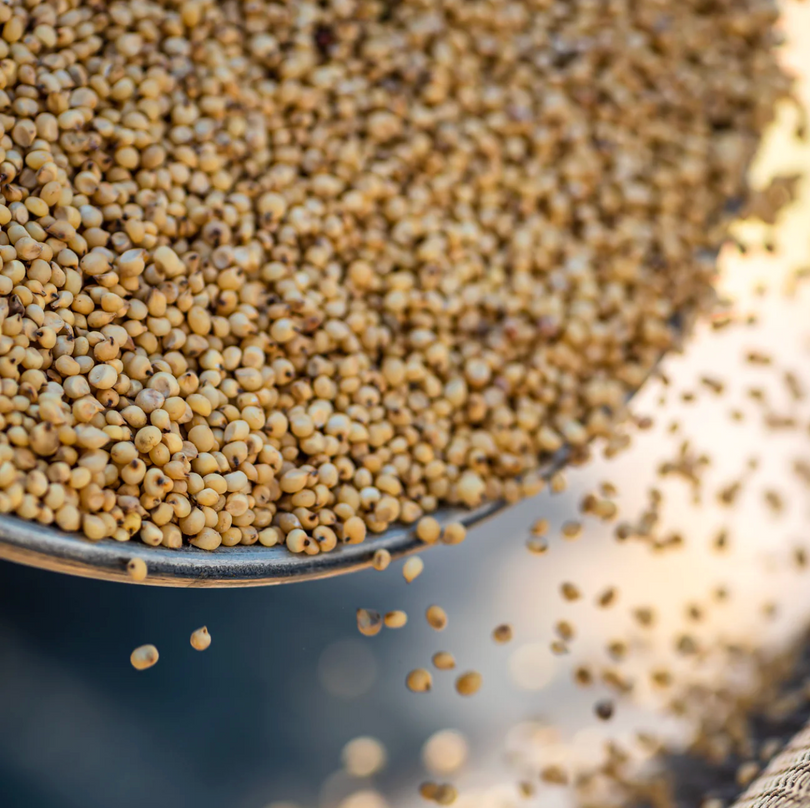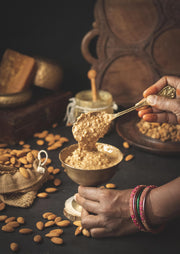This year we bring you a special series #NavaratriWithTBOF - one that is festive and colourful and a 'Culinary Celebration' of the colours of these 9 days of Navaratri! We will bring you ONE DELICIOUS RECIPE every day for these 9 days that will be all about the festive colour for that day.
In India we celebrate 9 forms of the Divine Mother through these 9 days and each day is assigned a colour each year.
#NavaratriWithTBOF - Day 1 Colour - Yellow
Shailaputri - the very first incarnation of Devi, the first Navadurga who is the Daughter of the King of the mountains, Himavat. The name literally translates as Shaila - Mountains, Putri - Daughter. She rides the bull ‘Nandi' and symbolizes strength and valour.
Yellow being the colour for the first day of Navaratri this year, gives us an opportunity to begin celebrations on a happy and bright note. Today’s recipe is one that is soaked in the brilliance of the yellow colour and belongs to the land of the mountains - A Kashmiri Paneer dish called Ruwangan Hachi Chaman
Written by Shanthini Rajkumar
Even if we go on a food exploration in India for the better part of our lifetime, there is little chance of being able to cover it in its entirety. Indian food as we know is so vast and diverse that going from one state to another is sometimes like exploring the cuisine of an entirely different country.
A disconnect with food happens when we move away from our traditional family recipes and gravitate more towards foods which are easy to cook, available throughout the year and involve minimum cooking time.
It is forgotten that food has a role to play which is more than just sustenance of life. It comforts, nurtures, nourishes and stays on in our memory banks. Often it is the one thing which ties us to a family member or friend who has passed on to a different realm.
The mixed feelings of love and loss when eating thin translucent rotis made by loving hands is one of the joys of living a human existence. The mind’s eye sees the floor on which the elder squatted, the knobbly sound of the rolling pin as it quickly dashed across the hand kneaded dough balls and these images feed the soul as well as the stomach.
Strangely enough, there is one ingredient which most Indians react in this manner to and that is undoubtedly our desi ghee. Each home for the most part has that quintessential ghee container, bulbous at the bottom and narrow at the top with a small ladle fashioned in a manner to add the correct amount of ghee to a person’s meal. How much thought has gone into fashioning the kind of containers our condiments were stored in.
Another reason that these ghee storing vessels were small is because the ghee was made regularly and in small batches. It was almost never re-heated and was used without fail at every meal.
Ghee recipes are therefore in abundance across the country. It did not matter if the cuisine of a particular area was cooked in gingelly oil or coconut oil, it also included a healthy dollop of ghee to finish the dish. The reason was that ghee contains good fats which help in the absorption of the spices and proteins prevalent in a dish. Furthermore, a gaushala was also a part of the Indian traditional living practices.
On exploring the cuisine of Kashmir one discovers that it is filled with so many influences. There is the Wazwan which is a compilation of dishes inspired by the Mughal diet, carried over from Persia. Filled with exotic flavours and spices, it is a culinary treasure trove of dishes. In the same region also exists the Kashmiri pandit cuisine, full of flavour but completely devoid of onion and garlic. It too boasts of an equally alluring cache of spices and aromas.

A dish which combines the best of these two varied diets is a robust, full bodied paneer dish called Ruwangan Hachi Chaman. There is a variation of the same without onions but both dishes are equally delicious.
Mustard oil is used to temper the ingredients and fry the cottage cheese but the final flourish happens by adding fresh coriander leaves and a generous spoonful of desi ghee.
It is a side dish which is easy to make and best eaten at this time of year when the clouds are gathering to slather a slew of raindrops over the ground which has withstood the harshness of summer.
The body too has to go from keeping itself cool and hydrated to adding foods which produce warmth and energy. A paneer and puri combo or a jeera pulao and paneer combo are just heavenly when eaten with the warmth of the fire still clinging to the underside of their bellies.

Ingredients like green cardamom, dry ginger, fennel, cinnamon and clove come together alongside juicy tomatoes cooked (and sundried) to retain their concentrated flavours and enhance the properties of lycopene. The paneer too is cut very specifically in large slabs rather than the more familiar cubes or rectangles. It is deep fried in cold pressed mustard oil before being allowed to soak in a warm water and turmeric bath.
This keeps the edges golden but the centres meltingly soft. A paneer dish which has an unctuous texture envelopes the diner in the loving cloak of home cooked goodness.
As the fingers reach down for the next morsel, there is no other thought but that of enjoying this dish and trying to identify the flavours that jump out and tease different points of the tongue to remind us of their role in the final taste of deliciousness.
There is no rushing while reading the newspaper or checking updates on the mobile phone. Meals like these demand that eating be taken seriously. After all, we are responsible for caring for our bodies. A hurried meal and quick swallowing of improperly chewed food only adds to physical and emotional discomfort .
Cooking a dish of this nature forces us to re-examine the role of food in our lives. It also inspires us to take the effort of sourcing the right foods which will not harm our health in any way. A bottle of A2 ghee made the traditional way is so vital in how our immune system functions. It is only when the gut assimilates food properly can the body’s warriors put up a good fight.
Recipe for Ruwangan Hachi Chaaman

Serves - 4
Paneer- 400 gms -cut into slabs
Tomatoes- 300 gms
Onions- 1 C chopped (optional)
Shahjeera-1 tsp
Fennel powder( saunf) - 1 Tbsp
Dry ginger powder-1/2 Tbsp
Asafoetida- a pinch
Cinnamon- 1 stick
Kashmiri red chilli powder- to taste
Himalayan salt-to taste
Mustard oil-to deep fry
Ghee- 2 Tbsps
Coriander leaves- chopped- 1/4C
Hot water- in a wide bowl
Steps
Add the mustard oil to a large kadai and gently deep fry each piece of paneer.
Mix the turmeric powder in the hot water and gently lower the fried paneer into the hot water /turmeric mix
Take a few tablespoons of the same mustard oil and add it to a medium sized pan. Add in the asafoetida. Add the whole spices; cinnamon, green cardamom and shah jeera. Add onions if using and saute until transparent. Add the tomatoes and saute until pulpy and the oil floats.
Add the red chilli powder, salt,dry ginger powder and (saunf) fennel powder and mix in well. Let simmer for a few minutes. Check seasoning and adjust as necessary.
Add in the paneer slabs and gently mix.
Take off the fire.
Garnish with the fresh coriander leaves and the desi ghee.
When a dish is topped with aromatic ingredients like fresh herbs and fragrant ghee, it whets the appetite and gets the digestive juices flowing.
Ayurveda talks about the importance of food colours and using fresh ingredients because eating is an experience which is enjoyed by other senses too. The sense of smell and sight are the first to react to a dish and prepare the sense of taste for what is in store.
Enjoying a meal , cooked at home, with carefully sourced ingredients is therefore a holistic experience. It has a huge bearing on how we are able to tackle life’s highs and lows. Once we understand this undeniable fact, food habits will veer away from going down the junk route.
The links below talk more about this special dish. Enjoy !
https://www.spiceroots.com/tamatar-chaaman-paneer-tomatoes-kashmiri-fusion-recipe/
https://food.ndtv.com/recipe-ruwangan-hachi-chaman-953396
Shop GHEE
Shop All Products - SHOP NOW













